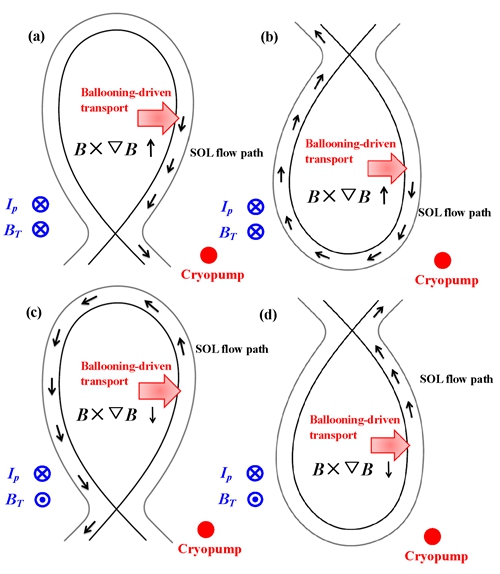
count: [2017-02-22] [Close]
ASIPP’s research work on low-to-high (L-H) confinement transition is included in the exclusive Nuclear Fusion 2016 Highlights collection recently, the sixth time that EAST team’s work has been selected in NF annual highlights collection consecutively since 2011.
Since the power available in the initial phase of ITER operation is limited, accessing the H-mode with a heating power as low as possible is a crucial issue. H-mode by limited radio-frequency wave heating power under lithium wall condition, with respect to different field direction and magnetic configuration, has been accessed in 2010 and 2012 EAST experimental campaign, respectively.
A comparison of the L-H power threshold and transition behavior for different field direction and magnetic field configuration has been carried out by EAST team and their collaborators. A minimum power threshold is found in double null configuration, and when operateed at single null configuration, L-H power threshold is lower for the ion grad-B drift away from the primary X-point. The effect of lithium wall conditions on the power threshold has also been discussed, which suggests a critical role by neutral recycling on the L-H transition. These results enrich the L-H power threshold studies in predominantly RF-heated plasma, which has significance for the H-mode operation of ITER.
The role of SOL flow on the L-H power threshold has been analyzed. First demonstration of the role of edge Pfirsh-Schlüter flow on low-to-high confinement mode transition in a fusion plasma, which has received extensive interests. (YAN Ning reports)
Links to highlight of 2011-2016:
http://iopscience.iop.org/journal/0029-5515/page/Highlights-of-2016
http://iopscience.iop.org/journal/0029-5515/page/Highlights-of-2015
http://iopscience.iop.org/journal/0029-5515/page/Highlights-of-2014
http://iopscience.iop.org/journal/0029-5515/page/Highlights-of-2013
http://iopscience.iop.org/journal/0029-5515/page/highlights-2012
http://iopscience.iop.org/journal/0029-5515/page/Highlights%20of%202011

Figure: Schematic view of parallel plasma flow at SOL region in LSN and USN configurations for B×∇B ↑ ((a) and (b)) and B×∇B ↓ ((c) and (d)) on EAST. The plasma current has never changed (counter clockwise).